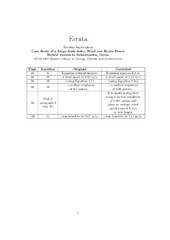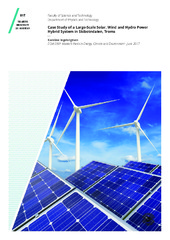| dc.contributor.advisor | Boström, Tobias | |
| dc.contributor.advisor | Thyrhaug, Svein Erik | |
| dc.contributor.author | Ingebrigtsen, Karoline | |
| dc.date.accessioned | 2017-10-05T08:04:08Z | |
| dc.date.available | 2017-10-05T08:04:08Z | |
| dc.date.issued | 2017-06-06 | |
| dc.description.abstract | The power company Troms Kraft is interested in the feasibility of a large-scale hybrid system in Skibotndalen in Troms. There are two existing hydro power stations in the area, and this thesis concerns the addition of an electric solar power plant of 20 MW and a wind power plant of 21 MW to these stations. As measured solar radiation is not available for one whole year at the location, solarradiation data is simulated by using the acknowledged WeatherResearch and Forecasting Model (WRF) tool for weather prediction. The technical performance of the hybrid system is simulated by using the software HOMER Pro, and by request from Troms Kraft, a simple economic analysis of the system is also done. The simulated solar radiation data overestimates the solar resource, but this is taken into account by scaling the data. However, correction of timing errors of the simulated data is not included.
In a hybrid system between several energy resources, a complementary nature between the resources is advantageous. Therefore, the anti-correlation between the solar and wind resource in the area is examined. Using simulated solar radiation values for 2016, a moderate negative correlation is found on longer time-scales such as weekly and monthly. Using measured values from the first four months of 2017, the anti-correlation is moderate on a weekly basis, and very high on a monthly basis. Using shorter time scales resulted in low to none anti-correlation. Both the solar and wind resource is found to be above what is required for feasibility for power production.
The results show that the technical feasibility of the system is good, but as there are large uncertainties in inter alia the simulated solar resource and because the losses in the power output due to turbulence are not included in the simulations, sensitivity analyses are done on these and other technical parameters. The interaction with the existing hydro power station is also examined. The economic analysis shows that the system is not profitable, but sensitivity analyses and a simulation of a future scenario with lower costs and higher efficiencies shows that the system can turn out to be profitable under certain conditions. | en_US |
| dc.identifier.uri | https://hdl.handle.net/10037/11625 | |
| dc.language.iso | eng | en_US |
| dc.publisher | UiT The Arctic University of Norway | en_US |
| dc.publisher | UiT Norges arktiske universitet | en_US |
| dc.rights.accessRights | openAccess | en_US |
| dc.rights.holder | Copyright 2017 The Author(s) | |
| dc.rights.uri | https://creativecommons.org/licenses/by-nc-sa/3.0 | en_US |
| dc.rights | Attribution-NonCommercial-ShareAlike 3.0 Unported (CC BY-NC-SA 3.0) | en_US |
| dc.subject.courseID | EOM-3901 | |
| dc.subject | Renewable energy | en_US |
| dc.subject | Hybrid system | en_US |
| dc.subject | Grid-connected | en_US |
| dc.subject | Large-scale | en_US |
| dc.subject | Skibotndalen | en_US |
| dc.subject | Troms | en_US |
| dc.subject | Solar | en_US |
| dc.subject | Wind | en_US |
| dc.subject | Hydro | en_US |
| dc.subject | VDP::Teknologi: 500::Elektrotekniske fag: 540::Elkraft: 542 | en_US |
| dc.subject | VDP::Technology: 500::Electrotechnical disciplines: 540::Electrical power engineering: 542 | en_US |
| dc.title | Case study of a large-scale solar, wind and hydro power hybrid system in Skibotndalen, Troms | en_US |
| dc.type | Master thesis | en_US |
| dc.type | Mastergradsoppgave | en_US |


 English
English norsk
norsk

